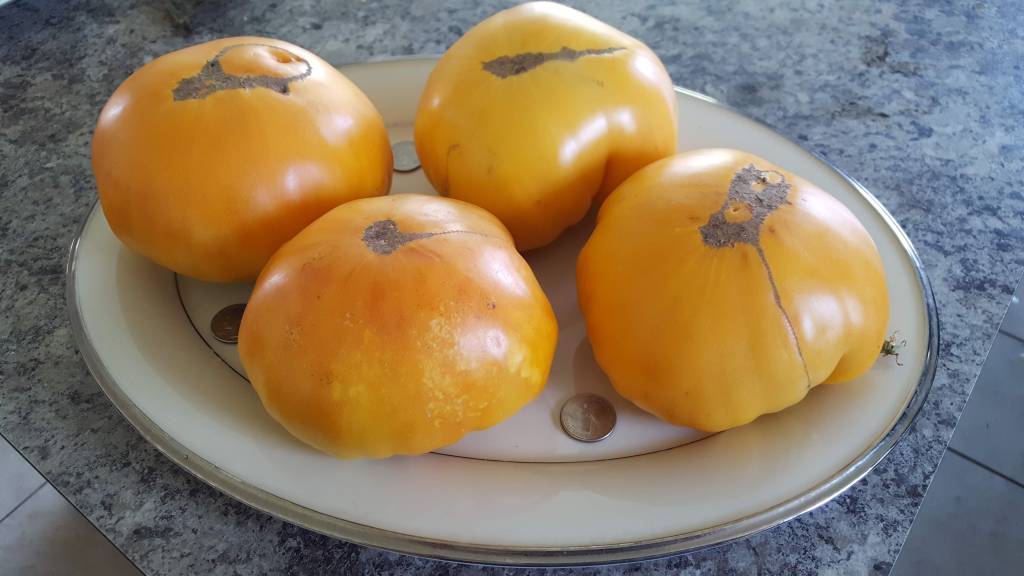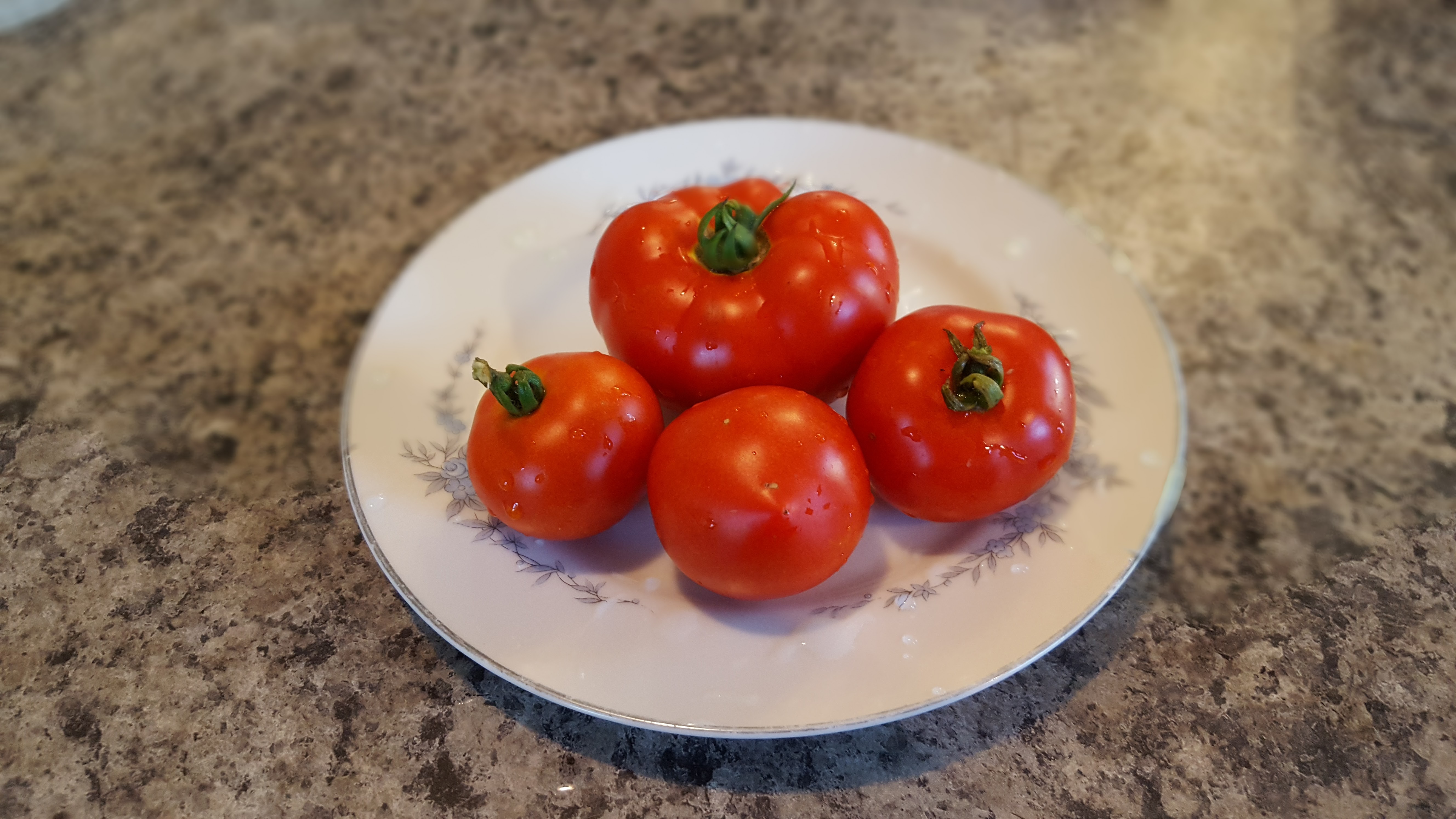
I’ve grown heirloom tomatoes most of my life. Now that I have a high tunnel, I’m not only looking for great taste, I’m looking for “well-adapted to life in a high tunnel.” Kellogg’s Breakfast fits both requirements.
Taste
This is a large (1 to 2 pounds!) beautifully orange beefsteak tomato that tastes as good as it looks. Although one of my chefs reports that she “never hides that color in a sandwich – the slice goes on the plate!” most reviewers slap a slice on their sandwiches for its nearly perfect sweet/acid balanced tomato flavor.
(Despite the name, ‘Kellogg’s Breakfast,’ I haven’t found anyone actually including the tomato as part of an Irish Breakfast, or any other breakfast dish. However, people do seem to love it in BLTs!)
Growing Characteristics
Kellogg’s Breakfast tomato is an indeterminate , regular leaf, large (need that leaf area to produce those beefsteak tomatoes!) plant which takes about 85 days to maturity. As beefsteaks go, it’s considered a mid-season producer with good yields that continue through the end of tomato season.
The stats are here.
High Tunnel Specifics
Plants are healthy and take trellising well. Disease resistance is good.
I was a little nervous about trellising a tomato plant whose fruits are 1 to 2 pounds each. (The record is 2.7 pounds) However, those stems are strong! Place a tomato trellis clip under the fruit bearing stem to support the tomato and in my experience, the stem holds onto that fruit!
None of my fruits have developed green shoulders or suffered from sunscald. The color is a deep, rich orange throughout the summer and into fall. (High tunnel tomato season ends at the beginning of October.) Yield (and quality) has been excellent throughout the season. Harvest before irrigating to prevent cracking.
Overall, Kellogg’s Breakfast plants thrive in the high tunnel. The tomatoes themselves look and taste great. If you want beefsteaks in your high tunnel rotation, there’s no horticultural or flavor reason not to grow them.
History
Kellogg’s Breakfast doesn’t have the storied history of some traditional heirlooms (it was introduced to Seed Savers Exchange in 1993), but its flavor is so good that in the mid 2000s, it began winning nearly every tomato taste test/festival where it was entered which inspired heirloom seed houses to offer it, which encouraged tomato connoisseurs to grow it!
The nitty-gritty particulars appear to be that Darrell Kellogg of Redford, MI, a railroad supervisor, found this tomato growing in his garden, liked it so much that he saved seed until it was stable, then gave seed to Bill Minkey of Darien, WI who introduced it to Seed Savers Exchange in 1993. Bill then gave seed to Carolyn Male, who thought well of it and its popularity has continued to this day. (Several sites have suggested that the original tomato was a West Virginia heirloom, but I have not been able to substantiate this claim. DNA vegetable testing – it needs to be funded!)
Grow This Tomato In Your High Tunnel!
The quest to find heirloom tomatoes that do well in a high tunnel continues. However, you can’t beat Kellogg’s Breakfast for flavor and adaptability to the high tunnel environment. Yeah, it’s orange (bright orange!) and it can be a honking big tomato. But it grows well enough that you can hand out samples and the taste will usually convince people to come back for more.




![close%20up%20PPP[1].jpg](https://hillcreekfarmpa.files.wordpress.com/2017/07/close20up20ppp13.jpg)
![many%20ppp[1].jpg](https://hillcreekfarmpa.files.wordpress.com/2017/07/many20ppp1.jpg)
![table%20ppp[1].jpg](https://hillcreekfarmpa.files.wordpress.com/2017/07/table20ppp1.jpg)
![Old%20Large%20Red%20Tomatoes[1].jpg](https://hillcreekfarmpa.files.wordpress.com/2017/07/old20large20red20tomatoes11.jpg)
![tomatoes%20and%20garlic[1].jpg](https://hillcreekfarmpa.files.wordpress.com/2017/07/tomatoes20and20garlic1.jpg)
![1st%20harvest%20asparagus%20processed[1].jpg](https://hillcreekfarmpa.files.wordpress.com/2017/07/1st20harvest20asparagus20processed1.jpg)
![Asparagus%20harvesting%20equipment%20April%202015[1].jpg](https://hillcreekfarmpa.files.wordpress.com/2017/07/asparagus20harvesting20equipment20april2020151.jpg)
![1st%20asparagus%20harvest%20basket[1].jpg](https://hillcreekfarmpa.files.wordpress.com/2017/07/1st20asparagus20harvest20basket1.jpg)
![1st%20harvest%20Purple%20Passion[1].jpg](https://hillcreekfarmpa.files.wordpress.com/2017/07/1st20harvest20purple20passion1.jpg)
![magnolia%20April%202015[1].jpg](https://hillcreekfarmpa.files.wordpress.com/2017/07/magnolia20april2020151.jpg)
![chickens%20with%20weeds[1].jpg](https://hillcreekfarmpa.files.wordpress.com/2016/04/chickens20with20weeds11.jpg)
![mulchedgooseberry[1]](https://hillcreekfarmpa.files.wordpress.com/2016/04/mulched20gooseberry1.jpg)
![strawallgooseberries[1]](https://hillcreekfarmpa.files.wordpress.com/2016/04/straw20all20gooseberries1.jpg)
![asparagus%20Feb516[1].jpg](https://hillcreekfarmpa.files.wordpress.com/2017/07/asparagus20feb5161.jpg)
![asparagus%20repotting[1].jpg](https://hillcreekfarmpa.files.wordpress.com/2017/07/asparagus20repotting1.jpg)
![asparagus%20repotted%20under%20lights[1].jpg](https://hillcreekfarmpa.files.wordpress.com/2017/07/asparagus20repotted20under20lights1.jpg)
![asparagus%20seeding,%20take%202[1].jpg](https://hillcreekfarmpa.files.wordpress.com/2017/07/asparagus20seeding20take2021.jpg)
![Galen%20Heat%20Mat[1].jpg](https://hillcreekfarmpa.files.wordpress.com/2017/07/galen20heat20mat1.jpg)
![PA%20asparagus%20growing%20lights[1].jpg](https://hillcreekfarmpa.files.wordpress.com/2017/07/pa20asparagus20growing20lights1.jpg)